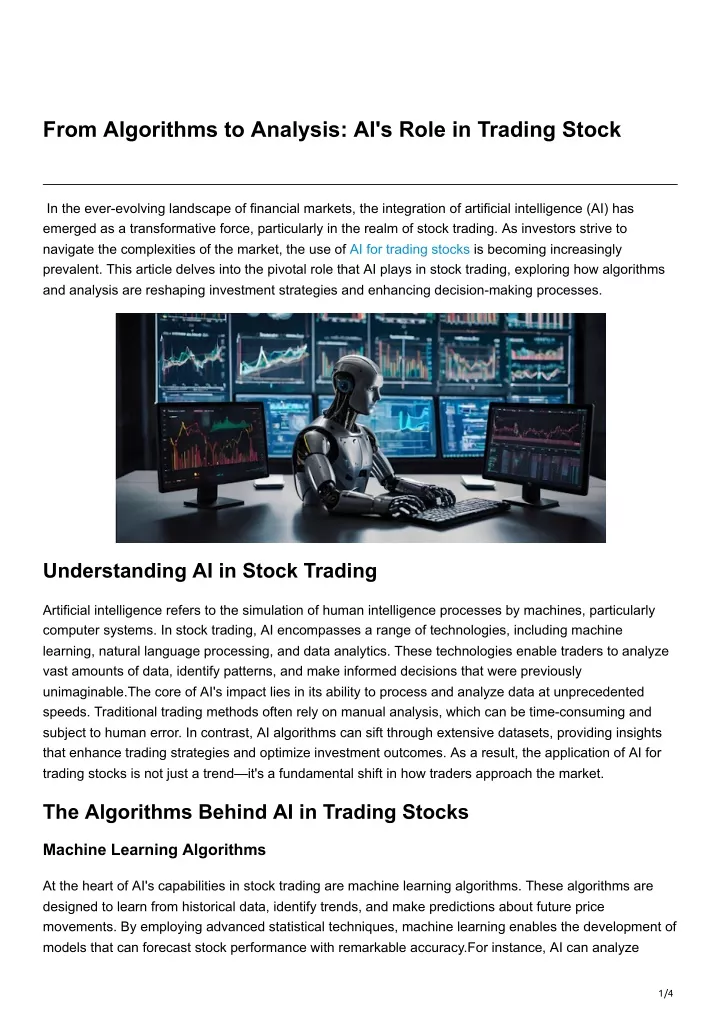Top 10 Tips To Evaluate The Strategy Customization Of AI stock Predicting/Analyzing Trading Platforms
Strategy customization is a crucial feature of AI stock Predicting/Analyzing trading platforms, as it allows users to customize the platform according to their specific trading goals and risk tolerance as well as market conditions. A platform that offers a variety of customizable options can help you improve your trading. Here are 10 guidelines for evaluating the flexibility of these platforms.
1. Evaluate Pre-Built Strategy Templates
A variety of templates: See if the platform offers an array of pre-designed strategies for different trading styles (e.g., swing trading, day trading, long-term investment).
Utilizability: Find out the ease with which these templates could be modified to meet your specific needs.
Performance history: Check whether the platform has historical performance data for pre-built strategies.
2. Review Custom Strategy Creation
Drag-and-drop tools: Select platforms with drag-and-drop interfaces that allow you to easily create custom strategies.
Check for coding options. For advanced users, it may be necessary to check whether the platform allows custom programming.
Flexibility: Ensure the platform lets you set your entry and exit parameters and risk management metrics as well as other crucial elements of your plan.
3. Check for Backtesting Capabilities
Historical data: Make sure that the platform is equipped with enough historical data to backtest strategies.
Customizable parameter: Make sure you have the ability to adjust parameters while backtesting (e.g. indicators, timeframes).
Performance metrics: Ensure that the platform has detailed metrics of performance (e.g. Win rate Sharpe Ratio, Drawdown) in the back-testing of strategies.
4. Evaluate Real-Time Strategy Testing
Paper trading: Ensure that the platform allows you to simulate or test your strategies without risking any money.
Live testing – See if you can test strategies with small amounts to see how they work.
Real-time Adjustments: Determine whether you can adjust your settings in real time according to the market’s conditions.
5. Evaluate the level of integration based on technological indicators
Libraries of indicators: Ensure that your platform comes with a comprehensive toolkit for technical analysis (e.g. MACD, RSI and moving averages).
Custom indicators. Make sure you are able to create or use customized indicators as part of your strategy.
Check if you can combine several indicators to make more complicated strategies.
6. Check for Risk Management Tools
Stop-loss/take-profit: Ensure the platform allows you to set stop-loss and take-profit levels within your strategies.
Position sizing – Check to see if you have any guidelines you can follow (e.g. the fixed amount or a percentage of your portfolio) for managing the risk.
Risk-reward-ratio: Check the platform’s support for setting risk/reward ratios for specific trades or trading strategies.
7. Evaluate Multi-Asset Strategy Support
Asset classes: Ensure that the platform provides strategies for multiple asset classes.
Cross-asset strategies: Determine whether you can make strategies that encompass multiple types of assets (e.g. pairs trading, hedges, etc.).
Market coverage – Make sure that the platform is covered by markets in which you are in (e.g. US and international markets or copyright, etc.).
8. Assess the automation and Execution
Automated trading: Make sure the platform is able to automate the execution of strategies that are based on established rules.
Order types: Find out whether the platform can support different kinds of orders (e.g., market, limit stop, limit) to execute a strategy.
Latency: Determine that the platform is able to perform trades that have minimal latency particularly when using high-frequency strategies.
9. Make sure to check out the Strategies Optimization Tools
Parameter optimization: Make sure the platform offers tools for optimizing strategy parameters (e.g. grid search or genetic algorithm).
Machine Learning Integration: Find out whether a platform is able to integrate machine learning to optimize and refine the strategy.
Analysis of scenarios: Check whether the platform permits testing strategies in different market conditions (e.g., bull, bear and volatile).
Review User Feedback and Community Support
User feedback Research user feedback to determine the efficacy of the platform for the development of a customized strategies.
Community forums: See whether the platform hosts an active community of users who share and discuss custom strategies.
Support sources. Make sure there are webinars or tutorials that can aid you in the creation and optimization of your strategies.
Bonus Tips
Trial period: Use the demo or trial version for free to test the platform’s strategy options for customization.
Scalability – Make sure that the platform you select can adapt to your changing trading strategies.
Support for customers: Find out if the platform can provide support for issues related to strategy and queries.
With these suggestions to evaluate the ability to tailor strategies for AI platforms for analyzing and predicting stocks Be sure to select a platform that aligns with your goals in trading and allows you to apply and refine your strategies effectively. A platform that offers flexible options for customization can allow you to adjust to changing market conditions and boost your trading performance. Check out the top rated look at this for chatgpt copyright for blog tips including market ai, ai investment platform, AI stock trading bot free, best ai trading software, AI stocks, ai for trading, investing ai, AI stock, ai for stock trading, best AI stock and more.

Top 10 Ways To Analyze The Updates And Maintenance Of AI stock Trading Platforms
It is crucial to evaluate the updates and maintenance practices of AI-driven stock prediction and trading platforms. This will ensure that they are secure and up-to-date with evolving market conditions. Here are 10 tips on how you can evaluate the maintenance and update procedures:
1. Updates frequency
Verify the frequency of updates on your platform (e.g. weekly, monthly or even quarterly).
Regular updates demonstrate active development of the product and an ability to react to market changes.
2. Transparency of Release Notes
Check out the release notes for the platform to find out the improvements or changes taking place.
Why? Transparent Release Notes show the platform’s commitment to continuous improvement.
3. AI Model Retraining Schedule
You can ask the AI model what frequency it is trained.
The reason is that markets change, and models must be updated to maintain precision.
4. Bug Solutions and Issue Resolution
Tips Check how fast a platform can address bugs reported by users or resolves technical problems.
Reason: Rapid corrections to bugs will ensure the platform’s reliability and usable.
5. Updates on Security
Tips: Make sure that the platform is updated regularly with its security protocols to safeguard the user’s data.
Why: Cybersecurity in financial platforms is vital to guard against breaches and fraud.
6. Incorporating New Features
TIP: Find out whether there are any new features that are being introduced by the platform (e.g. advanced analytics and data sources.) in reaction to feedback from users or market trends.
What’s the reason? New features demonstrate flexibility and responsiveness to user needs.
7. Backward Compatibility
Check to ensure that the updates won’t affect existing functionality, or require major reconfiguration.
Why: The software’s backward compatibility ensures smooth transitions.
8. Communication between Users and Maintenance Workers
Tips: Examine how the platform communicates scheduled maintenance or downtime to the users.
The reason: Clear communication reduces disruptions and builds trust.
9. Performance Monitoring and Optimization
Tip: Make sure your platform is monitoring and optimizing the performance of your system (e.g. accuracy, latency).
Why: Constant optimization makes sure that the platform is robust and flexible.
10. Compliance with changes to the regulatory framework
Tip: Determine if the platform offers new features or policies that comply with the financial regulations and privacy laws.
Why is this? Because compliance with the law is required to avoid legal liabilities and ensure consumer trust.
Bonus Tip! User Feedback Incorporated
Find out whether the platform integrates feedback from users into the maintenance and update process. This shows a user-centric approach and commitment to improvement.
If you evaluate the above elements, you will be able to determine whether or not the AI trading and stock forecasting platform that you pick is maintained, up-to-date, and able to adapt to the changing market conditions. Check out the most popular can ai predict stock market info for site examples including chart analysis ai, how to use ai for copyright trading, ai investment tools, chart ai trading, stock predictor, stock trading ai, invest ai, chart ai trading, best ai trading platform, ai options and more.


